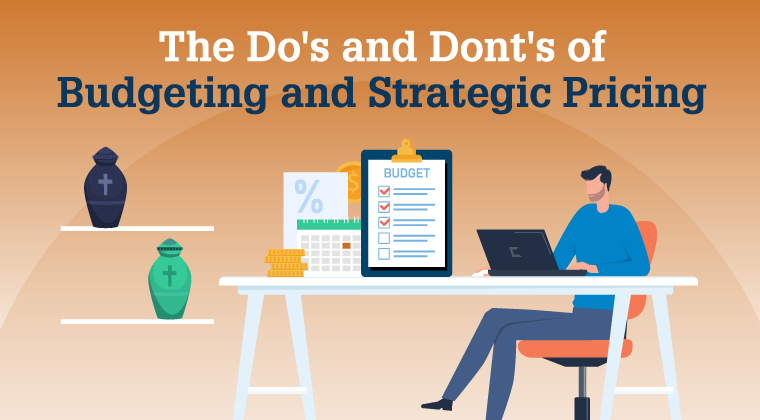To run a successful death care business, you’ll need to treat budgeting as an integral facet of your strategic planning — not just in the short-term but in the long-term, too. While industry trends can cause a funeral home’s revenue to grow or shrink within any given year, truly well-managed businesses will succeed in the long run, even for generations, regardless of the greater market climate.
Here are the dos and don’ts of budgetary planning.
1. DO plan for change every year.
If the 2020 pandemic taught us anything in death care, it’s that funeral businesses need to be adaptive. When in-person gatherings were no longer viable, funeral homes had to pivot to virtual ceremonies and other alternative means of honoring the deceased. With the market impacted so drastically, a funeral home’s plan for 2019 simply wouldn’t have worked for 2020 or 2021.
Additionally, trends and preferences continue to change over time. The growing preference for cremations over traditional burials, for example, is a long-term trend that funeral homes can’t ignore. Account for this in your budget plan every year and be on the lookout for other shifts in the profession.
In short, even industries as traditional as death care are subject to frequent changes and trends. The best funeral businesses will anticipate and react to these trends, then budget accordingly.
2. DO research.
As well as researching the plethora of market share trends among your competition, your team should conduct research in a variety of areas. Your accounting team should look into your business’s financial performance, perform regular funeral home valuations, and report them to your management team.
You’ll also want to consider any additional economic circumstances, such as inflation, interest rates, and taxes. For example, be sure to monitor pricing and labor costs when inflation is high.
3. DO divide your planning into short-term and long-term.
As you create plans for your funeral home, you’ll need both short- and long-term goals.
Your short-term plans will involve your goals for the immediate future in the 1-2 year range. These plans tend to be smaller steps and may consist of hiring new team members, reaching a benchmark of preneed sales, or renovating portions of your facilities – in other words, bite-size action steps that contribute toward a long-term key company initiative.
A long-term plan will explore more impactful company goals you hope to achieve in five years or more. These might include acquiring additional funeral or cremation businesses, starting a new business segment, or achieving a certain level of market share. Larger company initiatives like these will likely need to be allocated a chunk of the budget over time.
In most cases, it’s best to work from the top down. Determine your most important key company initiatives first, then break it down into smaller steps you must take to achieve it.
4. DO conduct a SWOT Analysis.
One of the biggest mistakes we see among funeral directors is neglecting to conduct a SWOT analysis. When thoroughly conducted annually, a SWOT analysis provides you with a thorough conception of where your business stands, allowing you to plan appropriately.
A SWOT analysis consists of four key components:
- Strengths: This consists of any areas in which your business currently excels. Ample sales of preneed services could be considered a strength.
- Weaknesses: Weaknesses are any areas of your business that stand to grow or improve. For example, low customer satisfaction reviews might be a weakness.
- Opportunities: Any outside factors that could present a boon to your business would fall into the category of opportunities. For example, a growing interest in cremation services presents the opportunity to capitalize on this market share.
- Threats: Threats refer to any factors that could potentially harm your business. For example, new competition and online value cremation businesses.
5. DO consider all facets of your operation.
As the saying goes, a chain is only as strong as its weakest link, and in many cases, it’s helpful to view businesses in the same manner. In order to ensure that your funeral home is operating at an optimal level, you’ll have to consider each of its aspects as it relates to the others.
Your service levels, strategic pricing initiatives, merchandising, competition, market share, preneed sales, demographics, team members, and financials all work together to create the picture of your funeral business. By examining each aspect of your business holistically, you can begin figuring out how to plan accordingly.
6. DON’T set and forget.
At the end of every month, take a close look at your budget and financial performance. This includes not only reviewing profit and loss statements but also examining balance sheets, cash flow statements, accounts payable, and accounts receivable.
If possible, you’ll also want to conduct a more formal review every few months with an accountant. While anyone can tell you if your business is currently profitable, only a skilled accountant can help devise strategies to more prudently manage your finances.
7. DON’T put it off.
The most efficiently managed companies are guided by both short- and long-term goals. The key to any business initiative is the proper availability of funds, making it imperative for funeral home owners and directors to place budgeting at the center of their business strategy. To kickstart your 2023 plans, you might consider reaching out to a team of consultants.
At Johnson Consulting Group, our team of death care consultants has collective decades of experience owning, operating, and advising funeral businesses. By partnering with your team, our consultants can help you develop business strategies that guide your funeral home in both the near and distant future. Our expert team of death care accountants can also help ensure that your financials are centered in these arrangements.
While the larger economic situation continues to fluctuate, funeral businesses with solid planning can weather any storm. To get started with your plans, give us a call.
START YOUR PLANS
